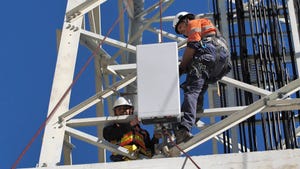Broadband equipment spending to dip again in 2024 – Dell'Oro
Operator spending on broadband gear will remain sluggish well into 2024, Dell'Oro predicts. But there are signs of a return to growth in 2025 as money from BEAD and other broadband subsidy programs trickle down to suppliers.

Broadband network suppliers weathered a tough 2023 amid lower customer spending fueled partly by operators paring down their existing inventory. Those issues are expected to persist and cause spending patterns to remain sluggish well into 2024, Dell'Oro analyst Jeff Heynen predicts in his outlook for the year.
Broadband network suppliers will be reporting their Q4 results in the coming weeks, but total spending on broadband equipment for 2023 is expected to show a decline of about 10%, Heynen notes.
"Early projections for 2024 indicate an additional 5% year-over-year decrease, as the lagging impact of interest rate increases to curb inflation will be felt more acutely. This additional 5% decrease would put total spending to around $16.5 B – roughly equal to 2021 spending levels," he explains.
Several suppliers have already warned that they don't expect operator spending on broadband gear to pick up until sometime in the second half of 2024. Suppliers are likely to provide updated expectations for 2024 as they issue Q4 2023 financial results in the coming weeks.
A continued slowdown would still amount to a reversal of fortunes for vendors, which saw spending surge from 2020 to 2022 because of network capacity enhancements spurred by the pandemic as people worked and schooled from home.
But it's a pattern that Heynen has seen before. He points out that similar periods of growth from 2003-2006 and from 2010-2014 were followed by two subsequent years of lower spending. But the drivers weren't always the same, he adds. In China, for example, capital spending shifted from broadband to mobile radio access networks (RAN).
A ray of sunshine in 2025
There's room for optimism, though, as Heynen sees "very early signals" of a return to growth in 2025 as money from subsidization programs, including funds for the Broadband Equity Access and Deployment (BEAD) program, "begin to trickle down to broadband equipment suppliers."
And before that, he also anticipates that there will be "pockets of growth" in areas such as fixed wireless customer premises equipment (CPE), cable distributed access architecture (DAA) gear and ongoing spending on passive optical networking (PON) among smaller tier 2 and tier 3 operators.
Drilling further into the cable segment, Heynen notes that operators will be taking a range of paths to stay competitive. Comcast is moving ahead with its DOCSIS 4.0 deployments based on Full Duplex (FDX) technology and collaborating with Broadcom on a family of "unified" chipsets for modems, amps and nodes that support both FDX as well as the extended spectrum flavor of D4.0.
Operators 'can't wait to deploy Wi-Fi 7'
Heynen also expects to see a new class of gateway from Comcast that incorporates the new, speedy Wi-Fi 7 standard. This week, the Wi-Fi Alliance announced it has established a test bed as it opens up certification testing on Wi-Fi 7 products. Comcast hasn't announced the next phase of its DOCSIS CPE roadmap, but there's already some speculation about a new gateway to be called the XB10. Comcast's current top-of-the-line DOCSIS 3.1 gateway, the XB8, supports Wi-Fi 6E.
"Operators can't wait to deploy Wi-Fi 7 products to help differentiate themselves in increasingly crowded broadband markets and to eliminate much of the confusion in the market with the coexistence of Wi-Fi 6 and Wi-Fi 6E," Heynen writes.
Among other operators, Heynen expects Charter Communications to ramp up its deployment of DAA and virtual cable modem termination systems (vCMTSs) this year. He also believes Charter and Cox Communications will move ahead with wider availability of new 1.8GHz amplifiers and taps that will help provide the basis for future DOCSIS 4.0 rollouts.
Recent court documents show that Charter has already engaged MaxLinear for D4.0 modems that support the extended spectrum DOCSIS (ESD) version of D4.0. Heynen believes that Charter will also adopt DOCSIS 4.0 silicon that supports both FDX and ESD. That would represent a nod for Broadcom's new unified chip and a decision by Charter to retain a dual-source approach to DOCSIS silicon.
Enhanced DOCSIS 3.1
The analyst also expects to see ongoing interest in enhanced/upgraded DOCSIS 3.1 networks – something that is being called DOCSIS 3.1 extended, "ultra" DOCSIS 3.1 or "boosted" DOCSIS 3.1 in some circles.
As Light Reading reported, Broadcom and MaxLinear are working on new D3.1 chipsets that can beef up downstream capacity and speed through the support of additional OFDM (orthogonal frequency-division multiplexing) channels. Some operators are likewise exploring the deployment of new D4.0 modems on their D3.1 networks to achieve similar capacity gains.
That approach could extend the life of DOCSIS 3.1 networks, delay D4.0 upgrades or become an interim step before a future leap to fiber-to-the-premises. But it's still not clear how many operators will pursue this path.
About the Author(s)
You May Also Like












